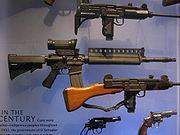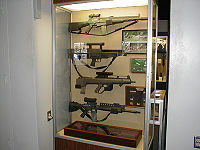
Colt ACR
Encyclopedia


Advanced Combat Rifle
The Advanced Combat Rifle was a United States Army program to find a replacement for the M16 assault rifle. The program's total cost is approximately US$300 million...
program, which concluded with the result that none of the entrants achieved enough of an improvement over the M16 to be worth the cost.
The Colt ACR was not a total loss, however; the scope went on to be offered by Elcan, a version of which was eventually adopted as the M145 Machine Gun Optic used on a number of firearms, especially those from Diemaco
Diemaco
Diemaco was a Canadian defense company based in Kitchener, Ontario, Canada, that manufactured the C7 family of rifles under a licence from Colt. It was acquired by Colt on May 20, 2005, in a $18.2 million purchase from parent company Héroux-Devtek Inc, which had purchased Diemaco in 2000....
.
Ammunition
The key design change was the use of "duplex rounds", a single cartridge with two bullets in it. Olin Corporation produced three different rounds for testing, the first consisting of two tungstenTungsten
Tungsten , also known as wolfram , is a chemical element with the chemical symbol W and atomic number 74.A hard, rare metal under standard conditions when uncombined, tungsten is found naturally on Earth only in chemical compounds. It was identified as a new element in 1781, and first isolated as...
projectiles in a long-necked case, the second used a standard-length case with two 27 grain (1.75 g) 0.158-inch (4 mm) tungsten projectiles, and the final entry was another standard-length case with two 0.224-inch (5.69 mm) projectiles, one 35 grains, (2.27 g) the other 33 (2.14 g). The latter was eventually selected for submission to the ACR trials. The basic idea of the duplex load is to increase the number of projectiles fired, which is the primary determinant of battlefield casualties. However, they significantly reduced accuracy, requiring the user to also carry traditional ammunition for long-range shots.
See also
- List of individual weapons of the U.S. Armed Forces
- Colt Automatic RifleColt Automatic RifleColt Automatic Rifle is a 5.56 mm NATO firearm offered by Colt Defense. It is based on the M16A2/A4, but features full automatic fire, an integrated bipod, and it can be configured to fire from an open bolt. The forward hand-grip has a distinctive squared off shape.It is one of many SAW-type...
- Project AbakanProject AbakanProject Abakan was a Russian advanced assault rifle programme in rival to the US Advanced Combat Rifle that took place between 1980 to 1994.-History:The 1960s ushered a new generation of assault rifles with the introduction of smaller calibers. U.S...
- Buck and ballBuck and ballBuck and ball was a common load for muzzle-loading muskets, and was very commonly used into the early days of the American Civil War. The load consisted of a .69 caliber round lead musket ball combined with three buckshot pellets.-Construction:...

